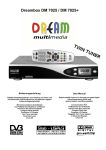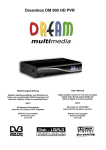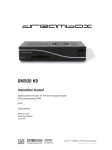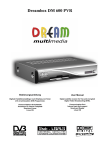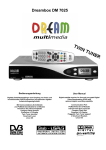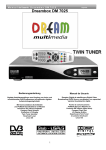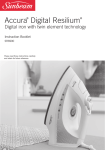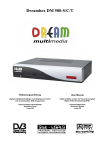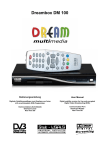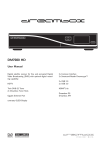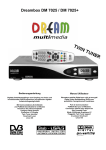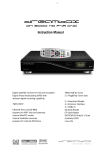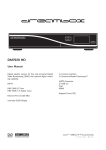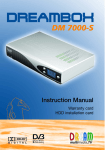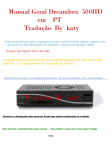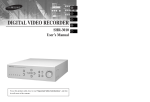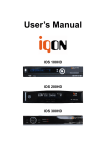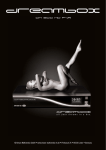Download Mitsubishi Dreambox DM 7025 User's Manual
Transcript
Dreambox DM 7025 Bedienungsanleitung User Manual Digitaler Satellitenempfänger zum Empfang von freien und verschlüsselten DVB-Programmen mit optionaler digitaler Aufzeichnungsmöglichkeit. Digital satellite receiver for free and encrypted Digital Video Broadcasting (DVB) with optional digital recording capability. Mit Kommunikations-Schnittstelle und PCMCIA-Schnittstelle für CI-Module Anschluss für interne Festplatte Compact Flash Schacht Grafisches LC-Display Twin Tuner steckbar Smartcard Leser Linux OS Communication-Port PCMCIA-Slot for CI-Modules Internal hard disk connector Compact Flash Slot Graphical LC-Display Pluggable Twin Tuner support 2 Smartcard Readers Linux OS User Manual Dreambox DM 7025 english Table of contents 1. Before initial operation of the receiver 1.1 Safety instructions ......................................................................- 5 1.2 Packaging contents ....................................................................- 8 1.3 Views ..........................................................................................- 9 1.3.1 Explanation front panel ...................................................- 10 1.3.2 Explanation rear panel....................................................- 11 1.4 Remote control .........................................................................- 13 - 2. Installation 2.1 Turning the device on ...............................................................- 19 - 3. Start wizard 3.1 Language selection ..................................................................- 20 3.2 Tuner setup ..............................................................................- 21 3.3 Service scan .............................................................................- 21 - 4. Basic operation 4.1 Turning your Dreambox on and off...........................................- 22 4.2 Service selection ......................................................................- 22 4.3 Changing channels using the service list .................................- 23 4.4 Controlling the volume..............................................................- 23 4.5 Changing the audio track..........................................................- 23 4.6 Sub services .............................................................................- 24 4.7 TV/Radio switching...................................................................- 24 4.8 Teletext.....................................................................................- 24 4.9 Infobar ......................................................................................- 25 - 5. Electronic Program Guide - EPG 5.1 Single-EPG...............................................................................- 26 5.2 Multi-EPG .................................................................................- 27 5.2.1 Time/Date Input ..............................................................- 28 - -2- User Manual Dreambox DM 7025 english 6. Edit the channellist 6.1 Add a bouquet ..........................................................................- 29 6.2 Add a service to favourites .......................................................- 30 6.3 Adding multiple services to a bouquet......................................- 31 6.4 Remove a service from favourites ............................................- 32 6.5 Moving a service to favourites ..................................................- 33 6.6 Adding a marker to favourites...................................................- 34 - 7. Hard disk operation 7.1 Mounting guidelines .................................................................- 35 7.2 Management ............................................................................- 42 7.3 Recording .................................................................................- 42 7.3.1 Instant recording .............................................................- 42 7.3.2 Stop recording ................................................................- 42 7.3.3 Recording by timer..........................................................- 43 7.3.4 Timeshift .........................................................................- 45 7.4 Watch a recording ....................................................................- 45 7.5 Delete a recording ....................................................................- 47 - 8. Teletext ................................................................................................. - 48 9. Picture-in-Picture mode (PiP) ............................................................. - 50 10. Setup 10.1 Language selection ................................................................- 51 10.2 Customize ..............................................................................- 52 10.3 Timezone................................................................................- 54 10.4 A/V Settings............................................................................- 55 10.5 RF output................................................................................- 57 10.6 LCD Setup .............................................................................- 58 10.7 Network ..................................................................................- 59 10.8 Common Interface..................................................................- 61 - -3- User Manual Dreambox DM 7025 english 11. Service searching 11.1 DVB-S Tuner configuration ....................................................- 62 11.1.1 Single satellite – direct connection ...............................- 63 11.1.2 Two satellites via Toneburst A/B ..................................- 64 11.1.3 Two satellites via DiSEqC A/B......................................- 65 11.1.4 Four satellites via DiSEqC A/B/C/D ..............................- 66 11.1.5 Stab positioner using USALS .......................................- 67 11.1.6 Tuner 2 setup................................................................- 68 11.2 DVB-C Tuner configuration ....................................................- 69 11.2.1 Tuner 2 setup (DVB-C) .................................................- 69 11.3 DVB-T Tuner configuration.....................................................- 70 11.3.1 Tuner 2 setup (DVB-T) .................................................- 70 11.4 Automatic scan.......................................................................- 71 11.5 Manual scan ...........................................................................- 73 - 12. System information 12.1 Service ...................................................................................- 74 12.2 About (Hard- and Software) ..................................................- 75 - 13. Troubleshooting .........................................................................................- 76 14. TV-Mode setup 14.1 Programming the remote control............................................- 77 14.2 Device list ...............................................................................- 78 - 15. Technical data .............................................................................................- 83 16. Contact & support information ...............................................................- 86 17. Copyright notes ..........................................................................................- 87 17.1 GNU GPL (General Public License) .......................................- 88 - 18. Menu overview ............................................................................................- 91 19. Service Slip ........................................................................ see PDF attachment -4- User Manual Dreambox DM 7025 1. english Before initial operation of the receiver 1.1 Safety instructions Please read the safety instructions completely and carefully, before using the Dreambox. The Manufacturer takes no responsibility for damages as a result of incorrect handling of the Dreambox. - Allow enough space around the Dreambox for sufficient ventilation. - Do not cover the top of the Dreambox and allow enough space to other devices. The louvers of the devices must be free at all times to allow sufficient heat transfer from inside the device. - Never put vases or any other liquid filled containers on top of the device. Do not expose the device to dripping or splashing liquids. - Do not place open flame sources, such as lit candles, on top of the device. - The device may only be operated in moderate climate. - Do not remove the cover. Risk of electric shock. If it is necessary to open the device please contact a trained professional. - Do not put any metal things into the slots or ventilation openings. - The installation of a hard disk is only allowed by skilled personal or your local dealer. ATTENTION! Modifications and changes to the Dreambox lead to loss of warranty if not performed and documented by skilled personal. ATTENTION! We recommend the installation of a hard disk by your local dealer. Unskilled installation of a hard disk leads to loss of warranty. -5- User Manual Dreambox DM 7025 english Shut down - In case your Dreambox is in use for a longer period of time disconnect the power plug from the power outlet. - During thunder storm the unit should also be physically disconnected from the power outlet. Additional safety instructions - (Dis-)Connecting to a LNB: Turn the Dreambox off before you connect or disconnect a cable coming from or going to a LNB. - Connecting to a TV: Before connecting or disconnecting your Dreambox to/from a TV please turn it off. - In case you notice any damage to the power cord or power plug immediately disconnect the device from the power outlet. - In case the device was exposed to humidity immediately disconnect the device from the power outlet. - In case you notice any serious damage to the outer shell of the device immediately disconnect the device from the power outlet. - Do not expose the Dreambox to direct sunlight, lightning or rain. - Grounding: The LNB cable must be grounded. The grounding system must meet SABS 061 requirements. - Cleaning: Disconnect the mains power cord before cleaning the cover. Use a slightly damp cloth without cleaning agents. - Connect the Dreambox only to suitable sockets. Do not allow overloads to occur. Note: The Dreambox DM 7025 carries the CE-Sign and fulfills all requirements from the EU. Version: 01-08-06 Subject to change without prior notification. -6- User Manual Dreambox DM 7025 english Disposal instructions The packaging of the Dreambox only consists of reusable materials. Please recycle if possible. This symbol on the product or on its packaging indicates that this product must not be disposed of with your other household waste. Instead, it is your responsibility to dispose of your waste equipment by handing it over to a designated collection point for the recycling of waste electrical and electronic equipment. The separate collection and recycling of your waste equipment at the time of disposal will help to conserve natural resources and ensure that it is recycled in a manner that protects human health and the environment. For more information about where you can drop off your waste equipment for recycling, please contact your local city office, your household waste disposal service or the shop where you purchased the product. Please note that empty batteries and electric waste is not to be put into the regular garbage. -7- User Manual Dreambox DM 7025 1.2 english Packaging contents Please check the completeness of the box’s contents. Included in box: 2 Batteries (1,5V Mignon / AA / LR6) Dreambox DM 7025 Remote control 1 IDE-Cable (already installed inside the device) 1 Power cord 1 HDD power cable (already installed inside the device) 1 User manual (most recent version online: http://www.dream-multimedia-tv.de ) -8- User Manual Dreambox DM 7025 1.3 english Views Front panel Remote control sensor CI-Slot Compact Flash Slot Smartcard Reader LC-Display Channel up/down Power button Rear panel Analog audio out 0 / 12V out Modem port Serial Port Network interface LNB ins/outs TV Scart Mains switch Mains connection VCR Scart Video out UHF Modulator in/out -9- Mini DIN Port Digital audio out USB port User Manual Dreambox DM 7025 english 1.3.1 Explanation Front Panel CI-Slot Plug in here any CI- Module of your choice. Compact Flash Slot The Compact Flash Slot is meant to hold a Compact Flash Module. The Compact Flash Module can be plugged in during regular operation. Smartcard reader Insert your Dreamcrypt Smartcard with the golden chip facing down and forward into one of the two Smartcard reader slots. Dreamcrypt is a registered trademark of Dream-Multimedia. Remote control sensor The remote control sensor receives the infrared signals of the Dream Remote Control. Channel up/down Using the channel-up and –down buttons you can switch the channels directly on your Dreambox. LC-Display (LCD) The graphical LC-Display shows all major Information for the selected service. Power button The Power-Button switches your Dreambox on and off. - 10 - User Manual Dreambox DM 7025 english 1.3.2 Explanation rear panel Mains switch The main power switch completely cuts power from your Dreambox. Mains connection Plug the power cable into the main power socket. You must not connect the power plug to anything other than a socket that supplies 110V/60Hz or 230V/50Hz. Analog audio out (RCA) Connect your Dreambox with a RCA/Cinch cable to your HiFi-Amplifier (e.g. AUX In or Tape In ports). Video out (Composite) You can optionally connect your Dreambox to a TV using a RCA/Chinch cable. TV Scart Connect your TV, projector or beamer to your Dreambox using a Scart cable. VCR Scart Connect your VCR or DVD player to your Dreambox using a Scart cable. Remember, the VCR Scart is not designed to record a video signal from the VCR or DVD player. UHF Modulator You can optionally connect your Dreambox to your TV via a coaxial cable. Network interface (Ethernet 10/100Mbit, RJ45) The Communication Port is an Ethernet port. It is used to communicate with your Dreambox via HTTP, FTP, NFS, Telnet and Samba to access your recorded movies, to upload channel lists, etc. This port is also used to update the operating system of your Dreambox. Please use a regular patch cable to connect your Dreambox to your LAN. USB port The USB Port is designed for devices that support the USB 1.1 standard. The amount of supported USB devices depends on the installed image (Software) and is still under development. B e d i e n u n g s a n l e i t u n g D r e a m b o x D M 7 0 2 5 User Manual Dreambox DM 7025 - 11 - User Manual Dreambox DM 7025 english Modem port (optional) You can optionally connect your Dreambox to your ISP via the Modem Socket using a phone line. The modem can be ordered from Dream Multimedia. Digital audio out (Toslink) You can connect your Dreambox with an optical (Toslink) cable to your HiFi-Amplifier or DSP. The AC3 signal is also available at this port in case the selected channel transmits Dolby Digital signals. Mini DIN Port The Mini DIN port is an expansion port. 0 / 12V out The 0 / 12V out provides a maximum current of 200mA and can be used to control your satellite equipment. Serial port (RS232C, Sub-D, 9-pol.) The Serial Port is used to update the operating system. Please connect a serial null modem cable here. LNB1 in (DVB-S Tuner) Connect the coaxial cable from your LNB here. LNB2 in (DVB-S Tuner) Connect the second coaxial cable from your LNB here. If you don’t have a second coaxial cable from your LNB available you can optionally use a coaxial cable to connect the LNB1 out with the LNB2 in. This offers you the option to have more channels available for parallel recording. LNB1 and LNB2 out (DVB-S Tuner) You can connect an analog/digital receiver here. Remember to shutdown your Dreambox into Deep-Standby-Mode in order for the receiver to work. Antenna in (DVB-C/T Tuner) Connect the coaxial cable from your antenna here. Antenna out (DVB-C/T Tuner) You can optionally connect your TV or VCR here. - 12 - User Manual Dreambox DM 7025 1.4 english Remote control SHIFT / SETUP-Button Power-Button DREAM-Mode-Button TV-Mode-Button Numeric-Keypad Arrow-Left-Button Arrow-Right-Button Mute-Button EXIT-Button Volume +/- Buttons Bouquet +/- Buttons INFO-Button MENU-Button Navigation-Buttons OK-Button AUDIO-Button VIDEO-Button Options-Buttons (PVR-Mode) HELP-Button TV-Button (PVR-Mode) RADIO-Button (PVR-Mode) TEXT–Button - 13 - User Manual Dreambox DM 7025 english Important notes about operation All functions of the Dreambox can be controlled via OSD-Menu (On-Screen-Display). This makes the handling of the Dreambox very easy for you. All options are indicated by four colored dots or beams (red, green, yellow, blue) in the OSD-Menu and can be started with the Option-Buttons on the Remote Control. Depending on the chosen Menu, these options do vary. The Options-Buttons of your remote control have multiple functions. You will notice control symbols below the four colored Options-Buttons, the TV- and the RADIO-Button. In PVRMode these buttons are used to control the digital recording according to their symbols. Pressing the VIDEO-Button on your remote control will activate the PVR-Mode. The Infobar will also indicate this. It changes from showing the channel information to showing the control symbols for the PVR-Mode. (also see 7.3.1. Instant recording) All Menus and Service lists are closed with the EXIT-Button. In general the menus are controlled using the Navigation-Buttons on your remote control. Navigation-Buttons - 14 - To get into a submenu you have to press the OK-Button. User Manual Dreambox DM 7025 english Explanation remote control buttons SHIFT / SETUP-Button The SHIFT/ SETUP-Button is used to preprogram the remote control to operate a TV. See chapter 14. TV-Mode setup. Power-Button The Power-Button switches your Dreambox on and off. See chapter 4.1 Turning your Dreambox on and off. DREAM-Mode-Button The DREAM-Mode-Button switches your remote control into Dreambox control mode. It will shortly light up once your press the button. TV-Mode-Button The TV-Mode-Button switches your remote control into TV control mode to control your preprogrammed TV. It will shortly light up once your press the button. See chapter 14. TV-Mode setup. Numeric-Keypad Enter a service number to directly access the option by using the Numeric Keypad. The service numbers are on the left side of the service list. The Numeric Keypad can also be used to enter the teletext page number when you are in TV-Control-Mode and if your TV is teletext capable. The TV station has to submit teletext information; otherwise this feature cannot be used. Arrow-Left-Button Arrow-Right-Button The Arrow-Left and Arrow-Right-Button enable you to jump back and forth between the last 20 channels you have watched. If you have selected a sub service (see chapter 4.6) you can use these buttons to switch to the next sub service. - 15 - User Manual Dreambox DM 7025 english Mute-Button Pressing the MUTE-Button mutes the Volume. A crossed speaker symbol will appear on the TV screen. Pressing it again or pressing one of the Volume +/- Buttons brings back the audio. EXIT-Button You can leave all menus and service lists by pressing the EXIT-Button. Volume +/- Buttons The Volume +/- Buttons control the volume of the audio. Pressing + will make turn it up and pressing - will turn it down. Bouquet +/- Buttons Pressing the Bouquet +/- Buttons will jump back and forth between the bouquets. INFO-Button If no OSD menu is visible on the screen and you are in TV or RADIO-Mode, pressing the INFO-Button will reveal the EPG information of the chose channel if it is available. Navigation-Buttons In general the menus are controlled using the Navigation-Buttons on your remote control. To get into a submenu you have to press the OK-Button. OK-Button By pressing the OK-Button you confirm a selection in the menu or service list navigation. If no OSD menu is present on your screen, the infobar is shown once you press the OKButton. - 16 - User Manual Dreambox DM 7025 english MENU-Button If you are in TV- or RADIO-Mode, pressing this button will bring up the OSD main menu. The OSD main menu has the following options: You can switch to the needed option by pressing the Navigation-Buttons up or down. If you are in the service list, pressing the MENU-Button brings up the service menu. The shown options may vary depending on the service list you selected. AUDIO-Button By pressing the AUDIO-Button you can choose the different audio tracks offered by the station. VIDEO-Button Pressing the VIDEO-Button activates the PVR-Mode. The Infobar will show the control symbols. You can instantly start recording by pressing the red Options-Button on your remote control. Options-Buttons (PVR-Mode) All possible options are shown by the four colored dots/blocks (red, green, yellow, blue) and can be activated by the Options-Buttons. These buttons have multiple functions and are also used to control the PVR-Mode. Depending on the menu you currently are in the options will change and will be named differently. - 17 - User Manual Dreambox DM 7025 english TV-Button (PVR-Mode) Pressing the TV-Button activates the TV-Mode. In PVR-Mode this button is mapped with the stop function as indicated by the small square underneath it. HELP-Button Pressing the HELP-Button activates the Help menu. RADIO-Button (PVR-Mode) Pressing the RADIO-Button activates the RADIO-Mode. TEXT–Button The TEXT-Button activates the Teletext. - 18 - User Manual Dreambox DM 7025 2. Installation 2.1 Turning the device on english - Place the batteries inside the battery compartment of the remote control keeping in mind the right polarity. - Before using the Dreambox, please read the safety instructions (See chapter 1.1 Safety instructions) - Connect the LNB or antenna with a coaxial cable to LNB1/2 in or Antenna in at your Dreambox. See chapter 1.3.2 Explanation rear panel. - Connect the Dreambox with a Scart cable to your television screen and if available connect your DVD Player or VCR to the VCR Scart of the Dreambox. - Plug in the power cable into the Dreambox and then into a 110V/60Hz or 230V/50Hz power socket. - If you are using a switchable power socket please shutdown your Dreambox into deep standby before switching off the power socket. See chapter 4.1 Turning your Dreambox on and off - If you switch on your Dreambox for the first time, you will see the setup wizard. The setup wizard will guide you through the first time installation. Follow the instructions on the screen. See chapter 3. Start wizard. - Please note that the factory setting for the video format is CVBS (FBAS). - 19 - User Manual Dreambox DM 7025 3. Start wizard 3.1 Language selection english Select your desired and language with the Navigation-Buttons up and down. Press the OKButton to activate. The start wizard takes you through the basic setup of your Dreambox. Press the OK-Button on your remote control to get to the next step. You will be asked if you want to set the basic settings for your Dreambox now or if you want to quit the start wizard. Using the Navigation-Buttons up and down select your desired option and press the OK-Button to activate your selection. If you chose “User wizard to setup basic features” you will be taken to the menu for the language selection. - 20 - User Manual Dreambox DM 7025 3.2 english Tuner setup Detailed information about the tuner setup can be found in chapter 11.1 DVB-S Tuner configuration 3.3 Service scan Detailed information about the service scan can be found in chapter 11.2 Automatic scan Finalizing the basic setup - 21 - User Manual Dreambox DM 7025 4. Basic operation 4.1 Turning your Dreambox on and off english Use the Power-Button to turn your Dreambox on and off. To put your Dreambox into Standby-Mode either press the Power-Button on your remote control or directly on your Dreambox. The current time will be shown in the Dreambox’s LCDisplay. Holding down the Power-Button on your remote control for three seconds will put your Dreambox into the Deep-Standby-Mode. You can also put your Dreambox into Deep-Standby-Mode by using the OSD main menu. Choose the Option “Standby / Restart” in the OSD main menu and navigate to “Deep Standby” option afterwards. Pressing the OK-Button will put your Dreambox into the DeepStandby-Mode. Alternatively you can push down the Power-Button on your Dreambox for 5 seconds. If no OSD Menu is visible on the screen this will also put your Dreambox into Deep-StandbyMode. All your settings will be saved now and your Dreambox goes into Deep-Standby-Mode afterwards (saves energy!). This is the Standby / Restart menu. Navigate to the desired option and confirm by pressing the OK-Button. Restart: Your Dreambox will be rebooted. Deep Standby: Puts your Dreambox into Deep-Standby-Mode. 4.2 Service selection Pressing the Left/Right-Buttons on your Dreambox remote control will take you to the previous or next service. Pressing the 0 on the Numeric-Keypad will enable you to skip back and forth between the two most recently watched services. This feature is quite useful during commercial breaks since it enables you to watch another channel and quickly check if your movies is back on. - 22 - User Manual Dreambox DM 7025 4.3 english Changing channel using the service list Pressing the Up/Down-Buttons on your remote control activates the service list. Use the Navigation-Buttons up/down to select the desired service and press the OK-Button to change to the selected service. 4.4 Controlling the volume The Volume +/- Buttons control the volume of the audio. Pressing + will make turn it up and pressing will turn it down. Pressing the MUTE-Button mutes the volume. A crossed speaker symbol will appear on the screen. 4.5 Changing the audio track Pressing the AUDIO-Button in TV or Radio Mode will reveal the “Audio” menu of the selected service. Use the Navigation-Buttons up and down to move to desired audio track. Press the OK-Button to select. The contents of this menu will vary from service to service. - 23 - User Manual Dreambox DM 7025 4.6 english Sub Services The green dot in the Infobar appears if the selected station transmits sub services. Pressing the green Options-Button in TV or Radio mode will reveal the sub services menu. Use the Navigation-Buttons up and down to move to one of the sub services. Press the OK-Button to select. 4.7 TV/Radio switching Pressing the RADIO-Button activates the RADIO-Mode. By pressing the TV- or EXITButton you can quit the RADIO-Mode. 4.8 Teletext Use the Text-Button to enter the teletext and the Exit-Button to leave. - 24 - User Manual Dreambox DM 7025 4.9 english Infobar The Infobar appears and disappears by pressing the OK-Button once, if no OSD menu is shown on your screen or when you change channels. The Infobar shows all necessary Information about the selected service. Channel name Signal level/strength Current show Next show Elapsed time Recording status Remaining time Current time Dolby Digital Is highlighted yellow as soon as a show is broadcasted encrypted. Is highlighted yellow as soon as a show is broadcasted in Dolby Digital. Is highlighted yellow as soon as a show is broadcasted in 16:9 aspect ratio. Record Options-Button Timeshifting Options-Button Subservices Extensions - 25 - User Manual Dreambox DM 7025 5. english Electronic Program Guide - EPG By pressing the INFO-Button in TV-Mode you are supplied with detailed information about the current show and by pressing the Right-Button afterwards about the next show. Pressing the yellow Options-Button activates the “Channel-EPG” (See chapter 5.1) and pressing the blue Options-Button activates the “Multi-EPG“ (See chapter 5.2). The Dreambox automatically searches for similar broadcasts in the background. If one or more similar broadcasts are found the label “Similar” will appear in the red window. Pressing the red Options-Button opens a listing of similar broadcasts. By pressing the green Options-Button you can set a timer for this rerun. For additional information about recording by timer please see chapter 7.3.3 Recording by timer. 5.1 Single-EPG In this view you are supplied with detailed information about the currently selected channel’s programming. - 26 - User Manual Dreambox DM 7025 5.2 english Multi-EPG Use the blue and yellow Options-Buttons to switch between the now, next and more views. Pressing the green Options-Button will give you the possibility to automatically copy the start and end time of the selected show into a recording timer.. If you have set the “Multi bouquets” option to “yes” (see chapter 10.2) a selection of you bouquets will appear. Select the bouquet for which you want the Multi-EPG view. This view shows the currently airing shows on the services listed in the left column. A progress bar showing the progress of the currently airing show is placed next to the service’s name. Using the Navigation-Buttons up and down you can select a service, just like in the service list, and change to the selected service by pressing the red Options-Button. General overview of the following programming. General overview of the upcoming programming for_the following days. (Depending on the station up_to_one week). - 27 - User Manual Dreambox DM 7025 english 5.2.1 Time/Date Input Press the Menu-Button in the Multi-EPG view. A A window will appear where you can enter a time and date. After you have entered the desired time and date press the OK-Button to activate you selection. The Multi-EPG will be displayed according to you set time and date. As a example we have selected 20:15. All shows starting 20:15 are displayed. User Manual Dreambox DM 7025 6. Edit the channellist 6.1 Adding a bouquet english Pressing the Up/Down-Buttons on your remote control activates the service list. Press the blue Options-Button to switch to the bouquet view. By pressing the Menu-Button the "Channellist menu" will open up. Navigate to the option "add bouquet". Use the Numeric-Keypad on your remote control to enter the name for the new bouquet. The according letters are printed on button. The Mute-Button deletes a character. Press the OK-Button to add the new bouquet to your favourites list. You will be taken back to the "Channellist menu". - 29 - User Manual Dreambox DM 7025 6.2 english Add a service to favourites If you want to add a service to your Favourites-view you can choose from services in the All-, Satellites- and Provider-views. You can switch views by pressing the red, green, yellow and blue Options-Buttons. At this point we only describe the process from the AllBouquet since it is the same for the others. Pressing the Up/Down-Buttons on your remote control activates the service list. Press the red Options-Button to change to the Allview. Use the Navigation-Buttons up/down to select the desired service and press the MENU-Button to open the “Channellist menu”. Navigate to the option “add service to bouquet”. If you are using more than one bouquet this option is named “add service to bouquet” instead and you will get a list of your bouquets afterwards. You can choose to which bouquet you want to add the currently selected service. If you are using only one bouquet which is the factory default, the service will be added to you favourites list. - 30 - User Manual Dreambox DM 7025 6.3 english Adding multiple services to a bouquet You can select multiple services from the All-view to be added to the currently selected bouquet. Pressing the Up/Down-Buttons on your remote control activates the service list. Use the Bouquet +/- Buttons to switch to the desired bouquet. As an alternative you can press the blue Options-Button and select the desired bouquet. After that select a service and switch to it by pressing the OK-Button. By pressing the Menu-Button the "Channellist menu" will open up. Navigate to the option "enable bouquet edit". The Allview will open up. All services that are in the selected bouquet are highlighted red. Use the Up/Down-Buttons to navigate to a desired service and press the OK-Button to select. The service will be highlighted red. Using this method you can select additional services that you want to add to the bouquet. Once you have selected all services that you want to add, press the Menu-Button. The "Channellist menu" will open up. - 31 - User Manual Dreambox DM 7025 english Choose the "End bouquet edit" option. All highlighted services will now be added to the bouquet that you selected in the beginning. If you are only using one bouquet, which is the default setting, the selected services will be added to you favourites list. 6.4 Remove a service from favourites Pressing the Up/Down-Buttons on your remote control activates the service list. Use the Navigation-Buttons up/down to select the desired service and press the MENU-Button to open the “Channellist menu”. Navigate to the option “remove service”. The selected service will be deleted from your favourites list. - 32 - User Manual Dreambox DM 7025 6.5 english Moving a service to favourites Pressing the Up/Down-Buttons on your remote control activates the service list. Use the Navigation-Buttons up/down to select the desired service and press the MENU-Button to open the “Channellist menu”. Navigate to the option “enable move mode” and press the OK-Button. Use the Navigation-Buttons up/down to select the service that you want to move and press the OKButton. The service will be highlighted red. Use the Navigation-Buttons up and down to move the service to the desired position. Press the OKButton to release the service and thus placing it at it’s new position. You can move services as long as the move mode is activated. To disable the move mode press the MENU-Button to get into the “Channellist menu” and chose the option “disable move mode” by pressing the OK-Button. . - 33 - User Manual Dreambox DM 7025 6.6 english Adding a marker to favourites You have the option to add makers within the favourites bouquets. Pressing the Up/Down-Buttons on your remote control activates the service list. Use the Bouquet +/- Buttons to switch to the desired bouquet. As an alternative you can press the blue Options-Button and select the desired bouquet. Select a service. The marker will be added above the selected service. By pressing the Menu-Button the "Channellist menu" will open up. Navigate to the option "add marker". Use the Numeric-Keypad on your remote control to enter the name for the new bouquet. The according letters are printed on button. The Mute-Button deletes a character. Press the OK-Button to add the marker to your favourites list. You will be taken back to the "Channellist menu". . As an example we have added two markers as shown in the picture on the left. Use the Arrow-Left and Arrow-Right-Buttons to jump between those two markers. - 34 - User Manual Dreambox DM 7025 7. Hard disk operation 7.1 Mounting guidelines english This chapter describes how to mount a hard disk inside your Dreambox DM 7025. Please always adhere to ESD (Electrostatic Discharge) regulations when handling electronic devices. Make sure that you are grounded. Do not open the device in your living room or in any other rooms with carpeting or any other flooring that can carry an electrostatic charge. Remove all connection from the device. Only open the device with the tools depicted in this manual. Try to avoid direct contact with the main circuit board. If all this doesn’t mean anything to you or if you have too many question, please contact your dealer or technician. Also notice the warranty notes in chapter 1.1 Safety instructions. This picture shows everything you need for installing the hard disk. Cover Hard disk Hard diskscrews - 35 - Cover screws Screwdriver User Manual Dreambox DM 7025 english Parts list 1 Dreambox (including the 11 Phillips screws for the cover and the hard disk cage). The IDE cable and the hard disk power cord a already installed inside the Dreambox DM7025. 1 Phillips screwdriver 1 Hard disk of your choice 4 Hard disk mounting screws Action: Remove these 5 screws on the rear panel. Remove these 2 screws at the right side of the device. Remove these 2 screws at the left side of the device. - 36 - User Manual Dreambox DM 7025 Lift the cover on the sides on slide it backwards. Remove the 2 screws from the hard disk cage. Remove the hard disk cage by lifting it upwards. - 37 - english User Manual Dreambox DM 7025 english Bend the IDE cable as shown in this picture. Now you need the Phillips screwdriver, the hard disk cage, the 4 hard disk mounting screws and your hard disk. - 38 - User Manual Dreambox DM 7025 english Attach the hard disk cage to the hard disk. Pay attention to the correct mount of the hard disk in the hard disk cage. Set the jumper of the hard disk to cable select. This information usually is printed on the hard disk. - 39 - User Manual Dreambox DM 7025 english Put the hard disk cage back into the Dreambox and connect the hard disk power cord and IDE cable to the hard disk. Please be careful not to lay the power cord too close to the powersupply. Screw the two screws back onto the hard disk cage. Slide the cover from the rear back onto the device.. Watch for the small plastic clips shown in the picture above. The must not overlap when you slide the cover back on! Screw the two screws on each side and five screws on the rear back into place. Reattach all connector to your Dreambox. Attach the power cord as last. - 40 - User Manual Dreambox DM 7025 7.2 english Management If no OSD menu is visible on your screen, press the Menu-Button to open the main OSD menu. Navigate to the option “Setup” and press the OK-Button to select. Navigate to the option “System” and press the OKButton. Navigate to the option “Harddisk…” and press the OK-Button. Navigate to the option “Samsung SV8004H (Internal - Master)” and press the OK-Button. If you have installed another hard disk this option will differ from the one depicted! By pressing the red Options-Button you will initialize (format) the hard disk. After you confirm the safety question the initialization process starts. Warning!!! All data stored on the HDD will be lost. - 41 - User Manual Dreambox DM 7025 7.3 english Recording 7.3.1 Instant recording Press the red Options-Button. You have four available options: - Add recording (indefinitely) - Add recording (stop after current event) - Add recording (enter recording duration) - Don't record Use the up/down-Buttons to navigate to you desired selection and press the OK-Button to select. A ongoing recording is indicated by a flashing symbol in the Infobar (see chapter 4.9). During a recording you can watch another service, view a previously recorded movie or add an additional recording. Pressing the Up/Down-Buttons on your remote control activates the service list. The recording continues in the background. 7.3.2 Stop recording Switch to the service which recording you want to stop. Press the red Options-Button, select the "Stop recording" option and press the OK-Button to select. The recording will be stopped immediately. - 42 - User Manual Dreambox DM 7025 english 7.3.3 Recording by timer With the help of a timer you can record shows (if you have a hard disk installed). You are offered two different ways to program a timer, the manual way of via the EPG. If no OSD menu is visible on your screen, press the Menu-Button to open the main OSD menu. Navigate to the option “Timer” and press the OK-Button to select. You see the “Timer Editor“ menu. Pressing the red Options-Button will delete a timer. The green Options-Button adds a timer, the yellow Options-Button toggles active on and off (only possible in waiting status) and the blue OptionsButton removes finished timers from the list. To edit an existing time select it and press the OKButton. The status of a timer is shown on the right side: - waiting means: still coming up - recording means: recording right now - done means: recording finished - the red X indicates that a timer was deactivated If you pressed the blue Options-Button you will be asked if you really want to delete the finished timer. Use the Navigation-Buttons up and down to select. Press the OK-Button to activate. - 43 - User Manual Dreambox DM 7025 english Manual programming Press the green Options-Button to add a new timer. You can choose between two different timer types. "Record" to record the desired show or "Zap" to automatically switch to the service. As repeat type you can choose between "once" and "repeated" The repeat type "repeated" offers you the folloing options: - daily - weekly with choice of weekdaay - Monday through Friday - user defined You can decide what should happen after the recording finishes by selecting the "After event" option. You can choose between "do nothing" to keep you Dreambox in the same state as before the recording or "Go to deep standby" to shutdown your Dreambox once the timer is done. Set you desired option by pressing the Navigation-Buttons up/down and left/right and press the green Options-Button to save the timer. Programming via EPG Change into on of the EPG views as described in chapter 5. By pressing the green Options-Button you have the option to automatically add the selected show with it’s start and end time as a timer. All other options are the same as in the manually added timer. Press the green Options-Button to save the timer. You will be taken to the “Timer Editor” menu. - 44 - User Manual Dreambox DM 7025 english 7.3.4 Timeshift Once you started an instant recording you can fast-forward and rewind while recording as long as you have already recorded at least 1 minute long. Press the yellow Options-Button to pause the screen (video and audio will pause). The recording will continue in the background. Press the yellow Options-Button again to resume watching. This way you won’t have to miss anything ever again if you quickly have to catch a phone call. The Timeshift-Mode can be exited by pressing the TV-Button. You will be asked if you want to quit the TimeshiftMode. Use the Navigation-Buttons up and down to select. Press the OK-Button to activate. 7.4 Watch a recording Press the Video-Button to get to the selection of recordings. Use the Navigation-Buttons up and down to select a recording. Press the OK-Button to start playing it. During replay you can see the control symbols in the Infobar. Press the Navigation-Buttons up and down or the Video-Button to get back to the list of recordings. If you have previously watched the movie you will be asked to continue where you left off when you start watching it the next time. If you do not make a selection withing 10 seconds the window will disappear and the movie starts from the beginning. You can see the control symbols for the PVR-Mode on you remote control below the Options-Buttons. - 45 - User Manual Dreambox DM 7025 english In PVR-Mode the Options-Buttons are mapped as described below: Green Options-Button Blue Options-Button Red Options-Button Yellow Options-Button TV-Button Keep in mind that you have to be in the PVR-Mode to use these options. You can check this by pressing the OK-Button. The Infobar will reveal and should show the depicted control symbols. If they are not shown you simply have to press the VIDEO-Button once again.. Red Options-Button = Rewind Green Options-Button = Play Yellow Options-Button = Pause Blue Options-Button = Forward TV-Button = Stop The Infobar does not have to be visible to use the PVR-Mode. The PVR-Mode can be exited by pressing the TVButton. You will be asked if you want to stop the replay of the recording. If you choose “Yes” you will be taken back to the last channel you were watching. Fast-forward/skipping within a movie Button 1: 30 sec. back Button 4: 90 sec. back Button 7: 270 sec. back Button 3: 30 sec. forward Button 6: 90 sec. forward Button 9: 270 sec. forward - 46 - User Manual Dreambox DM 7025 7.5 english Delete a recording Press the Video-Button to get to the selection of recordings. Use the Navigation-Buttons up and down to select a recording. Press the Menu-Button. Use the Navigation-Buttons up and down to select “Delete” and press the OK-Button. You will be asked if you want to delete the recording. As a control feature the name of the recording is displayed as well. Choose “Yes” and you will be taken back to the selection of recordings. - 47 - User Manual Dreambox DM 7025 8. english Teletext You are in the TV or Radio mode. Press the Text-Button to enter the teletext. Keep in mind that not every station transmits teletext! Teletext - regular navigation: If you are viewing any teletext page you can enter the interactive mode by pressing the OK-Button. Use the Navigation-Buttons to select a text page number and press the OK-Button to call this page. You don’t need to type in a text page number in this mode, but it is still possible. Press the EXIT-Button to exit. Press the Mute-Button a couple of times to toggle between transparent-mode, invisible-mode and full mode. The alpha-mode shows the picture from the running program through the text pages. The invisible-mode shows the complete picture from the running program without exiting the teletext. The full-mode brings back the text page. Press the Volume-up-Button to toggle between double high from the upper half, double high from the lower half and full view text page. Press the Volume-down-Button to activate or deactivate the PIG-Mode (Picture in Graphics). Same view from Text page and Program picture. (best results are show on 16:9 TV’s during 4:3 transmission). Teletext configuration menu: If the teletext page 100 is shown you can press the MENU-Button to enter the teletext configuration menu. - 48 - User Manual Dreambox DM 7025 english You have the following options: Teletext - Selection: Select the "Search" option and press the OK-Button to start searching for teletext information on other services without having to leave the service that you currently are watching. After the search is finished you can use the Navigation-Buttons left and right to select the teletext of another service without having to switch services. Press the OK-Button to select the desired teletext. This option is only available if more than one service on the current satellite transponder actually transmits teletext information. If this is not the case you cannot make a selection. Screen format: Standard mode 16:9 = on/off Enabling this shows the TuxText in 16:9 Aspect Ratio. Press the OK-Button to enable or disable this option. The default setting is disabled. Text/TV mode 16:9 = on/off Enabling this, switches the TV to 16:9 Aspect Ratio if the PIG-Mode is activated with the Volumedown-Button. Press the OK-Button to enable or disable this option. The default setting is disabled. Note: On some older 4:3 TV’s these Modes may not work. If enabled, it could happen, that your TV switches away from the VCR or A/V socket. If you are using a 4:3 TV, we suggest not to enable these modes. Brightness: Here you can adjust the brightness of your Teletext. Press the Navigation-Buttons left or right to adjust the brightness. Transparency: Here you can adjust the transparency value of your Teletext. Press the Navigation-Buttons left or right to adjust the alpha value. National characterset: automatic recognition = on/off The national codepage detection is used to display the teletextpages with the right letterset for your location. Press the OK-Button to enable or disable this option. The default setting is enabled. If disabled, use the Navigation-Buttons left or right, to choose your codepage. For further information see www.tuxtxt.net - 49 - User Manual Dreambox DM 7025 9. english Picture-in-Picture mode (PiP) The Dreambox has a so called PiP-Function. With PiP you can display a small TV picture ontop of the main big TV picture. Press the blue Options-Button and select the "Activate Picture in Picture" option. The main TV picture is now additionally displayed as a small PiP in the upper right corner of your screen and the last watched service is displayed in the main big TV picture. In PiP mode you will always hear the sound from the main TV picture. If you now switch services as you are used to the main TV picture will change, but the PiP stays. By pressing the blue Options-Button you can choose between the following options: 1. Disable Picture in Picture: Choose the option to turn the PiP mode off. The little PiP will disappear and only the main TV picture is displayed on your screen. 2. Move Picture in Picture: Choose the option to move or resize the small PiP. You can move the position of the small PiP by using the Navigation-Buttons up/down and left/right. Use the Bouquet +/- Buttons to resize the small PiP. Press the Exit-Button to discard your changes or the OK-Button to save the settings and return to the current TV show. 3. Swap services: Choose the option to swap the main TV picture and the small PiP. The small PiP becomes the main TV picture and vice versa. - 50 - User Manual Dreambox DM 7025 10. Setup 10.1 Language english If no OSD menu is visible on your screen, press the Menu-Button to open the main OSD menu. Navigate to the option “Setup” and press the OK-Button to select. Navigate to the option “System” and press the OKButton. The “System” menu will open up. Navigate to the option “Language…” and press the OK-Button. The “Language” menu will open up. Select your desired and language with the Navigation-Buttons up and down. Press the OKButton to activate. The Exit-Button will quit this menu. I - 51 - User Manual Dreambox DM 7025 10.2 english Customize If no OSD menu is visible on your screen, press the Menu-Button to open the main OSD menu. Navigate to the option “Setup” and press the OK-Button to select. Navigate to the option “System” and press the OKButton. The “System” menu will open up. Navigate to the option “Customize…” and press the OK-Button. - 52 - User Manual Dreambox DM 7025 english Recordings always have priority: If this option is set to “Yes” your Dreambox will automatically switch to the service which is supposed to be recorded incase there is a conflict with an existing timer. If you set this option to “No” you will be asked if you want to switch to the service which is supposed to be recorded. Margin before record (minutes): Set the desired forerun in minutes for a recording. Margin after record: Set the desired lag in minutes for a recording. Visualize positioner movement: If you own a satellite dish with a positioner you can see a flashing symbol of a satellite dish on your screen if you set this option to “yes”. Multi bouquets: Set this option to “Yes” if you want to use multiple bouquets. Change bouquets in quickzap: If this option is set to “Yes” you will automatically be taken to the next bouquet while changing channels once you have reached the end of one bouquet. Alternative radio mode: Set this option to “Yes” if you want the handling in the Radio mode to be the same as in the TV mode. - 53 - User Manual Dreambox DM 7025 10.3 english Setting the time zone If no OSD menu is visible on your screen, press the Menu-Button to open the main OSD menu. Navigate to the option “Setup” and press the OK-Button to select. Navigate to the option “System” and press the OKButton. The “System” menu will open up. Navigate to the option “Timezone…” and press the OK-Button. The “Time zone” menu will open up. Use the left/right-Buttons to select the desired time zone. Press the green Options-Button to save the setting or the red Options-Button to discard them. - 54 - User Manual Dreambox DM 7025 10.4 english A/V Settings If no OSD menu is visible on your screen, press the Menu-Button to open the main OSD menu. Navigate to the option “Setup” and press the OK-Button to select. Navigate to the option “System” and press the OKButton. The “System” menu will open up. Navigate to the option “A/V Settings…” and press the OK-Button. - 55 - User Manual Dreambox DM 7025 english Use the Navigation-Buttons left and right to change the values. Color format: CVBS (FBAS), RGB (Red, Green, Blue separated), SVideo (Color- and Brightness signal separated) Aspect ratio: 4:3 Letterbox (Standard), (16:9 programs will be displayed on 4:3 TV’s with black beams at top and bottom) 4:3 Panscan (16:9 programs will be zoomed to full high on 4:3 TV’s, parts of the picture on the left and right side will cut off) 16:9 (programs transmitted in 16:9 will be displayed automatically in 16:9, on 4:3 TV’s the picture will be reduced in height) 16:9 always (16:9 mode will be forced) 16:10 Letterbox and 16:10 Panscan (Choose these options if 4:3 and 16:9 result in a distorted view on your screen.) TV System: Choose the standard that your TV supports. PAL or NTSC. WSS on 4:3: Check the checkbox to disable zooming on some 16:9 TV’s during 4:3 transmissions. AC3 default: If a program is transmitted with an AC3 audio track (e.g. Dolby Digital), the Dreambox switches automatically to this audio track. The AC3 signal will only be available at the optical socket. The Dreambox has no built-in Dolby Digital Decoder, AC3 signals are not available on the analog socket, therefore you need an external Dolby Digital Amplifier to adjust the volume. VCR Switch: If this function is enabled (standard) the signal from the VCR Scart is directly passed to the TV. Depending on the model the this is either enabled when you turn on the device or when you start a replay. Press the green Options-Button to save the setting or the red Options-Button to discard them. You are taken back to the “System“ menu. - 56 - User Manual Dreambox DM 7025 10.5 english RF output If no OSD menu is visible on your screen, press the Menu-Button to open the main OSD menu. Navigate to the option “Setup” and press the OK-Button to select. Navigate to the option “System” and press the OKButton. The “System” menu will open up. Navigate to the option “RF output” and press the OKButton. Connect a TV to the UHF-out using a coaxial cable. Start a channel scan on your TV. The UHFModulator is set to channel 36. If this channel conflicts with any other existing devices you can easily change it. Use the Navigation-Buttons left and right to change the values. Press the green Options-Button to save the setting or the red Options-Button to discard them. - 57 - User Manual Dreambox DM 7025 10.6 english LCD Setup If no OSD menu is visible on your screen, press the Menu-Button to open the main OSD menu. Navigate to the option “Setup” and press the OK-Button to select. Navigate to the option “System” and press the OKButton. The “System” menu will open up. Navigate to the option “LCD Setup…” and press the OK-Button. Using the Navigation-Buttons left and right you can set the brightness and contrast of the LCD. “Standby” set the brightness value for standby. If “Invert” is set to “Yes” the polarity of the LCD will change. All changes will take effect immediately. Press the green Options-Button to save the setting or the red Options-Button to discard them. You are taken back to the “System“ menu. - 58 - User Manual Dreambox DM 7025 10.7 english Network If no OSD menu is visible on your screen, press the Menu-Button to open the main OSD menu. Navigate to the option “Setup” and press the OK-Button to select. Navigate to the option “System” and press the OKButton. The “System” menu will open up. Navigate to the option “Network…” and press the OK-Button. - 59 - User Manual Dreambox DM 7025 english Attention: If you are using a DHCP server in your LAN, configure the DHCP server so it does not assign the IP address used by the Dreambox. Otherwise an IP address collision is possible. Refer to the DHCP server’s manual about how to configure a DHCP address pool. Use the Navigation-Buttons and the Numeric-Keypad to change the values. Use DHCP: If enabled your Dreambox will get its IP from a DHCP server. Disable this option to set a static IP address. IP Address: Enter the IP address here. Netmask: Enter the subnet mask (Usually 255.255.255.0). Gateway: Enter the router’s IP address here, if the Dreambox is connected to the Internet over a router. Nameserver: Enter the DNS-Server’s IP address here. DNS is used to translate a Domain name to an IP address. Normally, if the Type is set to LAN, there is no need for a DNS entry. If the Dreambox is connected to the Internet over a router, enter the router’s IP address here. Activate the network: Press the OK-Button to save the setting and activate the network. - 60 - User Manual Dreambox DM 7025 10.8 english Common Interface If no OSD menu is visible on your screen, press the Menu-Button to open the main OSD menu. Navigate to the option “Setup” and press the OK-Button to select. Navigate to the option “Common Interface” and press the OK-Button. Reset: This options resets your CI-Module. This function is needed if you are experiencing trouble with one of your encrypted services. Init: This option initializes an inserted Smartcard. It is recommended to inset the CI-Module with the Smartcard already in it. No module found: No CI-Module is inserted into the slot. If you have inserted one the name and firmware version will show. Navigate to this option and press the OK-Button to get to the extended options of the inserted CIModule. The option strongly depend on the type of module inserted and therefore will not be explained in detail. Can decrypt multiple services: You can set if your CI-Module can decrypt multiple services or not. Please note that not every CIModule supports this feature. Check the instruction manual of your CI-Module for information about this feature. The “Auto” option only works with so called Alphacrypt Modules. The Exit-Button will quit this menu. - 61 - User Manual Dreambox DM 7025 11. Service searching 11.1 DVB-S Tuner configuration english If no OSD menu is visible on your screen, press the Menu-Button to open the main OSD menu. Navigate to the option “Setup” and press the OK-Button to select. Navigate to the option “Service searching” and press the OK-Button. The “Service searching” menu will open up. Navigate to the option “Tuner configuration” and press the OK-Button. Use the Navigation-Buttons up and down to select the “Socket A” (Tuner 1) and press the OK-Button. - 62 - User Manual Dreambox DM 7025 english 11.1.1 Single satellite – direct connection (DVB-S) Use this type of configuration if you want to receive a single satellite with a Single Universal LNB. The coax cable is directly connected from you Dreambox to the LNB. Please read the section 11.1 DVB-S configuration to learn how to get into this menu. The “Satconfig” menu will open up. Use the up/down-Buttons to navigate to the “DiSEqC-Mode” option and use the left/rightButtons to select “Single”. Navigate to the option “Satellite”. Use to the Navigation-Buttons left and right to select the desired satellite and press the OK-Button. You are taken back to the “Select slot“ menu. - 63 - User Manual Dreambox DM 7025 english 11.1.2 Two satellites via Toneburst A/B (DVB-S) Use this type of configuration if you want to receive two satellites from one LNB each. It does not matter if you use one or two dishes to achieve this. Connect the two coax cables form the two LNBs to a so-called Toneburst switch and connect the coax cable from the Toneburst switch to your Dreambox. Please read the section 11.1 DVB-S configuration to learn how to get into this menu. The “Satconfig” menu will open up. Use the up/down-Buttons to navigate to the “DiSEqC-Mode” option and use the left/rightButtons to select “Toneburst A/B”. For Port A and Port B select the desired satellites just as described in the Single satellite – direct connection section. Make sure you know which satellite is connected to which input on the Toneburst switch. If you do not find any services in the transponder scan later, exchange the two satellites in this list and try again. Press the OK-Button to save your settings. - 64 - User Manual Dreambox DM 7025 english 11.1.3 Two satellites via DiSEqC A/B (DVB-S) Use this type of configuration if you want to receive two satellites from one Twin Universal or Quad Universal LNB. It does not matter if you use one or two dishes to achieve this. In this case the LNBs are connected to a so-called Multiswitch from which the signal is via coax cabled to the satellite receivers (Dreamboxes) in your household. Please read the section 11.1 DVB-S configuration to learn how to get into this menu. The “Satconfig” menu will open up. Use the up/down-Buttons to navigate to the “DiSEqC-Mode” option and use the left/rightButtons to select “DiSEqC A/B”. For Port A and Port B select the desired satellites just as described in the Single satellite – direct connection section. Make sure you know which satellite is connected to which input on the Toneburst switch. If you do not find any services in the transponder scan later, exchange the two satellites in this list and try again. Press the OK-Button to save your settings. - 65 - User Manual Dreambox DM 7025 english 11.1.4 Four satellites via DiSEqC A/B/C/D (DVB-S) Use this type of configuration if you want to receive four satellites from one Single Universal or Twin Universal LNB for four or eight parties. It does not matter if you use one or two dishes to achieve this. In this case the LNBs are connected to a so-called Multiswitch from which the signal is via coax cabled to the satellite receivers (Dreamboxes) in your household. Please read the section 11.1 DVB-S configuration to learn how to get into this menu. The “Satconfig” menu will open up. Use the up/down-Buttons to navigate to the “DiSEqC-Mode” option and use the left/rightButtons to select “DiSEqC A/B/C/D”. For Ports A, B, C and D select the desired satellites just as described in the Single satellite – direct connection section. Make sure you know which satellite is connected to which input on the Toneburst switch. If you do not find any services in the transponder scan later, exchange the two satellites in this list and try again. Press the OK-Button to save your settings. - 66 - User Manual Dreambox DM 7025 english 11.1.5 Stab Positioner using USALS (DVB-S) Use this type of configuration if you want to receive many satellites with a Stab positioner from a Single Universal LNB. The coax cable is directly connected from you Dreambox to the LNB. Please read the section 11.1 DVB-S configuration to learn how to get into this menu. The “Satconfig” menu will open up. Use the up/down-Buttons to navigate to the “DiSEqC-Mode” option and use the left/rightButtons to select “Positioner”. This menu is meant for a Stab positioner. You only have to enter the geographical details of your residence. At http://www.heavens-above.com you can find the coordinates of your residence. The rest is done automatically by your Dreambox with build-in USALS. USALS is a model for calculating the position of all satellites in orbit with a margin of error less than 0.1 degrees. USALS was developed by the Stab company. Everything is done automatically and does not require any technical know-how. - 67 - User Manual Dreambox DM 7025 english 11.1.6 Tuner 2 setup (DVB-S) The same setup possibilities that applied for Tuner 1 also apply for Tuner 2. There are some additional configuration options. Equal to socket A: Use this setting if Tuner 2 should use the same settings as Tuner 1. Loopthrough to socket A: Use this option if you connected the LNB1 out to the LNB2 in. Nothing connected: Use this option if no cable is attached to Tuner 2. Secondary cable from motorized LNB: Use this option if you are using a positioner with a Twin- or Quad LNB and have 2 cables from the LNB connected to the LNB1 and LNB2 in. Tuner 1 controls the positioner and using Tuner 2 you can continue watching TV on the same satellite while recording. All others are grayed out. - 68 - User Manual Dreambox DM 7025 11.2 english DVB-C Tuner configuration Please read the section 11.1 DVB-S configuration to learn how to get into this menu. Use the Navigation-Buttons up and down to select the DVB-C Tuner and press the OK-Button. The default setting for this option is “ALL (SR6900)“. Use the Navigation-Buttons left/right to change this option to “ALL (SR6875)” if you cannot find any services during a service scan. Press the OK-Taste to activate your selection. You will be taken back to the “choose Slot” menu. 11.2.1 Tuner 2 setup (DVB-C) The same setup possibilities apply if you are using a second DVB-C tuner in your Dreambox (see chapter 11.2 DVB-C Tuner configuration). - 69 - User Manual Dreambox DM 7025 11.3 english DVB-T Tuner configuration Please read the section 11.1 DVB-S configuration to learn how to get into this menu. Use the Navigation-Buttons up and down to select the DVB-T Tuner and press the OK-Button. Choose your region by pressing the NavigationButtons left/right. If you have connected an active antenna and you want to run the antenna without it’s original power supply set the “Enable 5V for active antenna” option to “On”. Press the OK-Button to save your settings. 11.3.1 Tuner 2 setup (DVB-T) The same setup possibilities apply if you are using a second DVB-T tuner in your Dreambox (see chapter 11.3 DVB-t Tuner configuration). - 70 - User Manual Dreambox DM 7025 11.4 english Automatic scan If no OSD menu is visible on your screen, press the Menu-Button to open the main OSD menu. Navigate to the option “Setup” and press the OK-Button to select. Navigate to the option “Service searching” and press the OK-Button. The “Service searching” menu will open up. Navigate to the option “Automatic scan” and press the OK-Button. The “Automatic scan” menu will open up. Set the “Clear before scan” option to “Yes” if you want to delete all services before the scan starts. Otherwise leave the setting to “No”. Use the Navigation-Buttons up/down to select a tuner and the Navigation-Buttons left/right to enable or disable the scan for the selected tuner. Press the OK-Button to start the scan for all tuners which option is set to “Yes”. - 71 - User Manual Dreambox DM 7025 english You can see the progress of the scan here. The scan is done once you see this menu. It shows how many channels were found during the scan. Press the OK-Button to close this menu. - 72 - User Manual Dreambox DM 7025 11.5 english Manual scan If no OSD menu is visible on your screen, press the Menu-Button to open the main OSD menu. Navigate to the option “Setup” and press the OK-Button to select. Navigate to the option “Service searching” and press the OK-Button. The “Service searching” menu will open up. Navigate to the option “Manual scan” and press the OK-Button. The “Service scan” menu will open up. Use the Navigation-Buttons left/right to select the tuner on which you want to run the manual service scan. All other options can be changed by using the Navigation-Buttons left/right and depend on the type of tuner that you want to run the scan on. Press the OK-Button to start the manual scan. - 73 - User Manual Dreambox DM 7025 12. Systeminformation 12.1 Service english If no OSD menu is visible on your screen, press the Menu-Button to open the main OSD menu. Navigate to the option “Information” and press the OK-Button to select. The “Information” menu will open up. Navigate to the option “Service” and press the OKButton. This window shows detailed technical information about the current service. Press one of the four Options-Buttons to get the following information: red = Serviceinfo green = PIDs yellow = Transponder blue = Tuner status Press the OK-Button to close this menu. - 74 - User Manual Dreambox DM 7025 12.2 english About (Hard- and Software) If no OSD menu is visible on your screen, press the Menu-Button to open the main OSD menu. Navigate to the option “Information” and press the OK-Button to select. The “Information” menu will open up. Navigate to the option “About…” and press the OKButton. This window shows all relevant information about the Hard- and Software of your Dreambox. Press the OK-Button to close this menu. - 75 - User Manual Dreambox DM 7025 13. english Troubleshooting Problem No audio, no video, LCD lit Possible cause Faulty wiring Check wiring and connections Faulty LNB Exchange LNB Wrong Tuner setting Review settings (see 11.1 DVB-S configuration) Dish aligned incorrectly Realign dish Beamlike blackouts in the video Heavy rain or snow Realign dish Dish is too small Install larger dish An obstacle between dish and satellite (e.g. house or tree) Reposition dish so it has a clear “view” towards the satellite Check dish Dish aligned incorrectly or faulty No reception of the channels: Sat1, Pro7, Kabel … Channel is transmitted in a new slot The transmission of the channel was terminated Interference from a wireless DECT phone Dreambox does not react Remove snow from dish Dish aligned incorrectly No reception on a channel that was working before You cannot record anything anymore Remote control is not working Solution Start service scan (see chapter 11) Batteries are inserted incorrectly Batteries are empty Increase distance between the phone’s base station and the Dreambox or buy a coaxial cable with a higher shielding value Delete no longer needed recordings Remove batteries and check polarity Insert new batteries Wrong remote control mode (Dream-Mode, TV-Mode) Software is not reacting Press Dream-Mode or TVMode button Reboot Dreambox Dreambox is locked up Reboot Dreambox Hard disk is full - 76 - User Manual Dreambox DM 7025 14. english TV-Mode setup A four digit device code is selected from the device list and entered into the remote control. The most recent device list can be found on our website. SHIFT / SETUP-Button TV-Mode-Button Numeric-Keypad 14.1 Programming the remote control - Press the TV-Mode-Button once. - Press the SHIFT/Setup-Button for 3 seconds, the TV-Mode-Button will flash twice. - Use the Numeric-Keypad to enter the four digit device code into the remote control. The TV-Mode-Button will flash once for every digit you enter. Once you have entered all four digit the TV-Mode-Button will flash twice. - The remote control exits the programming mode automatically. - If no code is entered within 10 seconds the remote control will exit the programming mode automatically. - 77 - User Manual Dreambox DM 7025 14.2 english Device list A.R. Systems Accent Admiral Adyson Agashi Agazi AGB Agef Aiko Bazin Beko Beon Best Bestar Binatone 0067 0382 0067 0117 0123 0448 0243 0294 0247 0246 0246 0294 0546 0117 0246 0039 0067 0401 0065 0463 0102 0391 0221 0294 0247 0067 0391 0238 0401 0067 0463 0221 0065 0039 0102 0248 0193 0546 0586 0578 0510 0247 0661 0246 0294 0248 0312 0485 0067 0248 0389 0312 0039 0442 0294 0067 0248 0265 0039 0448 0400 0385 0401 0067 0246 0277 0193 0517 0066 0698 0609 0106 0236 0324 0247 0067 0247 0430 0350 0400 0039 0546 0294 0248 0401 0463 0442 0067 0039 0294 0039 0106 0294 0067 0400 0132 0039 0067 0404 0193 0353 0441 0289 0277 0042 0458 0503 0429 0531 0139 0226 0363 0228 0246 0429 0247 0067 0586 0042 0193 0430 0135 0376 0100 0134 0117 0067 0106 0039 0248 0294 0246 0312 0247 0067 0246 0236 0289 0350 0039 0193 0430 0067 0139 0247 0400 0367 0294 0248 0458 0247 0400 0294 0106 0117 0236 0267 0106 0379 0247 0277 0366 0041 0066 0039 0187 0404 0442 0067 0268 0139 0373 0102 0247 0238 0410 0193 0248 0039 0404 0067 0597 0193 0312 0247 0333 0225 0542 0067 0221 0391 0379 0535 0040 0247 0400 0067 0067 0448 0367 0400 0067 0400 0404 0247 Deitron Denko Desmet Diamant Digiline Dixi 0067 0294 0350 0067 0067 0067 0039 0067 0277 0247 Aim Akai Akiba Akura Alba Alcyon Allorgan Allstar Amplivision Amstrad Anglo Anitech Ansonic Apollo Arc en Ciel Arcam Aristona Arthur Martin ASA Asberg Asora Asuka Atlantic Atori Auchan Audiosonic Audioton Ausind Autovox Awa Ayomi Baird Barco Basic Line Bastide Baur Black Star Blacktron Blackway Blaupunkt Blue Sky Blue Star Bondstec Boots BPL Brandt Brinkmann Brionvega Britannia Brother Bruns BSR BTC Bush Capsonic Carad Carena Carrefour Cascade Cathay CCE Centurion Century CGE Cimline City Clarivox Clatronic Clayton CMS Hightec Concorde Condor Contec Continental Edison Cosmel Crezar Crosley Crown CS Electronics CTC Cybertron Daewoo Dainichi Dansai Dansette Dantax Datsura Dawa Daytron Decca General Technic Genexxa Germanvox Goldhand Goldline GoldStar - 78 - 0277 0312 0312 0221 0225 0230 0243 0357 0358 0348 0248 0312 0485 0067 0517 0698 0312 0277 0247 0312 0067 0531 0139 0429 0235 0267 0363 0226 0228 0317 0365 0448 0067 0549 0067 0117 0246 0247 0294 0117 0193 0324 0248 0248 0265 0193 0379 0039 0066 0312 0067 0385 0401 0404 0549 0294 0391 0517 0238 0324 0247 0698 0294 0640 0067 0485 0067 0066 0100 0039 0067 0067 0067 0067 0117 0243 0277 0268 0104 0114 0336 0106 0277 0193 0448 0400 0039 0265 0248 0039 0448 0100 0248 0294 0400 0401 0247 0106 0277 0067 0039 0132 0350 0609 0415 0247 0039 0246 0277 0312 0350 0067 0400 0039 0132 0441 0448 0246 0039 0187 0041 0066 0531 0139 0267 0226 0228 0429 0363 0235 0317 0517 0039 0367 0243 0117 0277 0104 0114 0106 0193 0243 0039 0400 0106 0067 0389 0609 0448 0238 0517 0277 0246 0248 0277 0248 0039 0067 0246 0404 0248 0247 0248 0246 0067 0294 0065 0246 0442 0400 0238 0067 0039 0404 0067 0102 0546 0067 0247 0039 0248 0067 0442 0243 0246 0367 0067 0400 0039 0247 0277 0246 0193 0391 User Manual Dreambox DM 7025 Domland Drean DTS Dual Dumont Dux Dynatron Elbe Elcit Elekta Elin Elite Elman Elta Emerson Emperor Erres Etron Euro-Feel Europa Europhon Expert Exquisit Fenner Ferguson Fidelity Filsai Finlandia Finlux Firstline Fisher Flint FNR Formenti Fortress Fraba Friac Frontech Fujitsu Fujitsu General Funai Galaxi Galaxis GBC GE Geant Casino GEC Geloso General IInterfunk Internal Intervision Irradio Isukai ITC ITS ITT ITV 0424 0067 0039 0379 0247 0373 0289 0366 0549 0067 0382 0424 0429 0333 0117 0134 0132 0243 0247 0100 0102 0067 0042 0067 0465 0268 0289 0400 0193 0067 0248 0221 0441 0640 0117 0277 0546 0132 0193 0294 0312 0246 0067 0135 0134 0578 0391 0379 0193 0039 0248 0067 0132 0039 0294 0243 0117 0277 0067 0401 0100 0312 0350 0312 0067 0042 0067 0039 0193 0294 0067 0067 0546 0132 0243 0247 0277 0193 0236 0430 0289 0193 0067 0277 0404 0039 0317 0365 0268 0139 0590 0655 0246 0401 0193 0294 0067 0247 0238 0376 0389 0578 0391 0135 0134 0067 0376 0247 0102 0193 0106 0546 0100 0117 0132 0441 0661 0522 0324 0351 0246 0067 0404 0415 0277 0039 0193 0132 0247 0441 0379 0561 0268 0102 0265 0698 0238 0134 0247 0066 0238 0400 0585 0117 0187 0391 0193 0333 0379 0102 0067 0485 0102 0248 0132 0117 0243 0246 0350 0193 0106 0123 0117 0400 0067 0039 0067 0132 0277 0294 0379 0247 0039 0236 0102 0132 0247 0193 0039 0294 0324 0132 0067 0400 0448 0067 0132 0243 0193 0039 0404 0248 0590 0139 0317 0365 0373 0193 0430 0102 0193 0391 0235 0546 0067 0247 0379 0243 0277 0039 0193 0404 0139 0317 0501 0067 0042 0117 0542 0357 0193 391 0400 0531 0139 0067 0312 0247 0485 0067 0401 0549 400 0424 0517 0248 0132 193 0294 0277 039 0067 0248 0277 0106 248 0067 0312 247 067 0401 0248 0312 0294 0246 193 0510 0379 0391 0503 0578 597 0376 0238 294 0067 0277 Goodmans Gorenje GPM Gradiente Graetz Granada Grandin Gronic Grundig Halifax Hampton Hanimex Hanseatic Hantarex Hantor Harwood HCM Hema Hemmermann Hifivox Hikona HiLine Hinari Hisawa Hit Hitachi Hitsu Hornyphone Hoshai Huanyu Hygashi Hyper Hypersonic Hypson Iberia ICE Ices Imperial Indesit Indiana Ingelen Inno Hit Innovation Interactive Interbuy Matsui Mediator Medion Megas Melvox Memorex Memphis Mercury Metz - 79 - english 0066 0102 0067 0039 0294 0546 0404 0517 0401 0586 0373 0265 0065 0510 0590 0247 0365 0400 0248 0067 0083 0391 0067 0430 0256 0389 0042 0102 0138 0238 0247 0106 0066 0546 0503 0365 0590 0312 0248 0430 0067 0039 0350 0193 0485 0609 0640 0247 0132 0225 0221 0517 0100 0106 0235 0267 0067 0586 0294 0246 0247 0246 0247 0324 0067 0312 0379 0193 0391 0424 0243 0350 0458 0400 0039 0324 0247 0549 0039 0243 0067 0132 0067 0039 0442 0067 0294 0039 0312 0442 0247 0248 0448 0067 0247 0039 379 0531 0139 0226 0429 0248 0294 0067 0238 0066 0067 0248 0039 0193 385 0473 0517 0265 0324 0312 0248 0430 0485 117 0255 0066 0379 0503 0193 0373 0226 0228 0247 0336 0224 0546 0102 0067 0135 0586 0180 0578 039 0485 0248 0067 0042 0248 0485 0404 0246 0247 0246 0039 0246 0247 0277 0391 0067 0294 0247 0312 0485 0430 268 067 294 0247 0067 0401 0248 0246 039 248 0246 0067 0277 0400 0448 0193 0561 104 0114 0106 0379 0226 267 0243 0067 0517 0640 0039 0102 0067 0248 0247 0106 546 0277 0549 0441 0039 0294 0277 0265 0039 0385 0041 0102 0066 067 0586 0517 0247 0324 401 0463 0473 0609 0485 379 0546 0065 0193 0238 225 0221 0365 0067 0586 0042 0067 0698 0549 0640 0430 0039 0367 0102 0039 0415 0067 0039 0117 0225 0243 0221 0397 User Manual Dreambox DM 7025 Jea JEC JVC Kaisui Kamp Kapsch Karcher KB Aristocrat Kendo Kennedy Kingsley Kneissel Kolster Konka Kontakt Korpel Korting Kosmos Kotron Kraking Kyoshu Kyoto Lemair Lenco Lenoir Lesa Leyco LG Liesenkotter Lifetec Lloyd’s Loewe Logik Logix Luma Lumatron Lux May Luxor Madison Magnadyne Magnafon Mandor Manesth Manhattan Marantz Marelli Mark Masuda Osume Otto Versand Pael Palladium Palsonic Panama Panasonic Panavision Pathe Cinema Pathe Marconi 066 065 0683 0083 0066 0401 0248 0248 0312 0067 0246 0485 0247 039 0246 0236 0193 0391 0289 0134 0067 0400 0312 0132 0640 0294 0193 0265 0277 0132 0067 0458 0400 441 0640 0236 0243 0193 0465 0246 0465 0289 0400 0268 0067 0441 640 0067 0248 0401 0067 0517 0067 0117 0400 0350 0067 0442 0294 0268 0294 0442 0415 0193 0441 0039 0134 0193 0067 0039 277 0294 0102 0067 0324 0609 067 0400 0039 0247 0277 0246 193 0391 0067 0357 0358 0039 0294 0549 0067 0404 0248 698 0039 0542 0067 0117 0400 0041 0401 0698 0236 0067 0193 0289 0441 0404 039 0236 0067 0193 0289 0391 0247 0294 0067 0039 0224 0267 0510 0522 0379 0391 238 0578 0193 0376 0067 0117 0277 0546 0132 0193 0546 0243 0106 0132 0246 0294 0067 0265 0247 0294 0350 0065 324 0067 0067 0117 0067 0247 0246 0404 0039 0248 0187 0102 0066 0248 0040 0535 0066 0123 0542 0067 0586 0225 0379 0221 0391 0265 0139 0243 0324 0256 0277 0333 0350 0247 0246 0400 0067 0221 0535 0040 0230 0448 0586 0277 0357 0379 0117 0193 0243 0247 0441 0685 0294 0442 0067 0039 0247 0294 0246 0067 0277 0256 0680 0280 0244 0243 0391 0267 0397 0546 0067 0193 0578 0067 0441 0193 0268 0246 0430 0350 0379 0235 0243 0531 0139 0226 0228 0363 0429 0267 Micromaxx Minerva Minoka Mitsubishi Mivar Monaco Motion MTC Multistandard Multitec Multitech Murphy NAD Naiko Nakimura National NEC Neckermann NEI Nesco Network Neufunk New Tech New World Nicamagic Nikkai Noblex Nobliko Nogamatic Nokia Nordmende Novatronic Oceanic Okano Omega Onwa Opera Orbit Orion Orline Ormond Osaki Osio Oso Reflex Revox Rex RFT Roadstar Robotron Royal Lux Saba Sagem Saisho Salora Sambers Samsung - 80 - english 0067 0698 0517 0225 0100 0106 0221 0267 0442 0067 0389 0138 0180 0542 0067 0117 0066 267 0400 0106 0246 0039 0106 0400 0379 0542 0132 0067 0698 0247 0379 0039 0246 0277 0132 400 0067 0134 0246 0102 0193 0391 0067 0404 0067 0267 0244 0256 0066 0350 0485 0039 0404 0247 0067 0067 0221 0400 0535 0040 0230 0586 0193 0357 0448 0379 0117 0243 0277 0247 0441 0067 0367 0401 0277 0367 0067 0039 0586 0640 0067 0039 0586 0373 0247 0248 0246 0102 0248 0067 0247 0294 0065 0367 0246 0039 0066 0067 0294 0132 0106 0100 0246 0429 0531 0139 0226 0391 0193 0510 0379 0578 0522 0389 0503 0238 0404 0661 0376 0139 0531 0317 0429 0226 0373 0228 0243 0605 0590 0225 0067 0365 0067 0135 0597 0193 0430 0391 0324 0238 0400 0067 0294 0102 0294 0401 0248 0463 0067 0067 0265 0324 0350 0385 0041 0067 0039 0351 0132 0473 0586 0685 0294 0442 0067 0248 0415 0698 0102 0248 0247 0294 0067 0442 0404 0067 0248 0067 0067 0400 0236 0441 0277 0193 0289 0117 0400 0458 0102 0294 0039 0294 0248 0448 0117 0400 0442 0317 0243 0117 0429 0193 0139 0531 0546 0373 0391 0528 0226 0228 0365 0235 0655 0578 0485 0640 0312 0265 0546 0039 0041 0247 0193 0294 0224 0379 0193 0389 0391 0546 0578 0243 0546 0106 0132 0067 0586 0617 0039 0247 0400 0294 0246 0102 0238 User Manual Dreambox DM 7025 Pausa Perdio Perfekt Pershin Philco Philharmonic Philips Phoenix Phonola Pioneer Pionier Plantron Playsonic Poppy Portland Prandoni-Prince Precision Prima Prinz Profex Proline Prosonic Protech Provision Pye Pymi Quadra Vision Quasar Quelle Questa R-Line Radialva Radiola Radiomarelli RadioShack Radiotone Rank RCA Recor Rediffusion Redstar Starlite Stenway Stern Strato Sunkai Sunstar Sunwood Superla Supertech Supra Susumu Sutron Swissline Sydney Sytong Tandberg Tandy Tashiko Tatung Teac TEC 0039 0102 0350 0193 0067 0067 0430 0117 0114 0104 0448 0106 0243 0277 0193 0400 0067 0247 0586 0067 0042 0353 0221 0117 0373 Sandra Sanela Sansui Sanyo 0067 0117 0350 0400 0415 0246 0193 0102 0067 0586 0042 0117 0246 0067 0458 0400 0373 0391 0139 0400 0067 0294 0039 0247 0039 0404 0277 0546 0391 0243 0106 0247 0039 0294 0102 0379 0224 0039 0193 0351 0102 0067 0042 0655 0067 0244 0246 0400 0404 0609 0401 0067 0247 0039 0277 0379 0132 0294 0448 0367 0698 0067 0067 0586 0042 0117 0039 0430 0277 0067 0040 0041 0531 0139 0542 0379 0221 0391 0066 0247 0277 0104 0114 0357 0336 0100 0134 0135 0187 0225 0230 0243 0294 0698 0066 0067 0139 0248 0193 0067 0067 0586 0042 0353 0117 0546 0277 0067 0067 0039 0067 0458 0400 0609 0448 0294 0442 0100 0590 0655 0365 0067 0391 0578 0066 0067 0039 0193 0067 0294 0312 0248 0236 0289 0193 0067 0294 0039 0324 0385 0351 0485 0248 0265 0067 0517 0401 0067 0039 0067 0039 0546 0246 0039 0067 0246 0586 0404 0039 0365 0039 0277 0246 0247 0246 0397 0441 0139 0367 0226 0391 0248 0102 0247 0277 0123 0066 0247 0246 0389 0193 0102 0546 0247 0067 0041 0067 0542 0485 0294 0039 0442 0379 0247 0039 0277 0501 0365 0367 0289 Schneider Save SBR Schaub Lorenz SEG SEI Seleco Sencora Sentra Serino Sharp Shorai Siam Siarem Siemens Sierra Siesta Silva Silver Singer Sinudyne Sogera Solavox Sonitron Sonneclair Sonoko Sonolor Sontec Sony Sound & Vision Soundwave Ssangyong Standard Unic Line United Universum Univox Vestel Vexa Videologique VideoSystem Videotechnic Videoton Vidikron Viper Visiola Vision Vistar Vortec Voxson - 81 - english 0246 0247 0268 0067 0401 0238 0187 0066 0041 0400 0102 0246 0247 0134 0243 0039 0193 0067 0585 0067 0067 0586 0042 0379 0578 0067 0586 0042 0333 0379 0549 0424 0382 0366 0289 0353 0373 0247 0277 0401 0248 0391 0193 0698 0247 0294 0039 0277 0066 0132 0193 0067 0246 0698 0517 0117 0132 0040 0193 0546 0379 0243 0324 0236 0067 0236 0289 0193 0441 0039 0065 0248 0039 0485 0640 1223 0123 0187 0066 0324 0683 0083 0324 0067 0193 0117 0132 0243 0221 0230 0225 0243 0357 0358 0187 0067 0067 0586 0042 0400 0246 0067 0066 0391 0117 0132 0277 0430 0465 0039 0117 0265 0132 0243 0324 0193 0391 0546 0379 0040 0236 0067 0350 0391 0102 0193 0578 0238 0400 0247 0067 0067 0039 0294 0312 0247 0238 0597 0193 0430 0535 0040 0578 0067 0400 0324 1535 1040 1681 0535 0040 0041 0030 0066 0132 0681 0104 0132 0248 0404 0067 0350 0448 0039 0248 0039 0247 0350 0067 0404 0067 0503 0067 0376 0135 0225 0503 0391 0277 0522 0510 0400 0230 0448 0041 0542 0324 0066 0187 0100 0193 0294 0134 0067 0441 0104 0336 0243 0357 0358 0040 0535 0106 0379 0247 0531 0139 0367 0661 0698 0367 0117 0067 0193 0268 0067 0193 0247 0039 0067 0246 0248 0247 0067 0246 0350 0247 0193 0132 0367 0246 0067 0350 0236 0391 0067 0117 0106 0067 0448 User Manual Dreambox DM 7025 Tech Line Technema Technisat Tedelex Teleavia Telecor Telefunken Telefusion Telegazi Telemeister Telesonic Telestar Teletech Teleton Televideon Televiso Temco Tempest Tensai Tenson Tevion Texet Thomson Thorn Tokai Tokyo Tomashi Toshiba Towada Trans Continens Trident Tristar Triumph Uher Ultravox 0067 0698 0350 0685 0247 0139 0531 0317 0226 0429 0235 0363 0520 0067 0193 0248 0247 0289 0424 0139 0531 0528 0501 0429 0317 0104 0114 0131 0365 0292 0336 0373 0226 0067 0655 0067 0067 0193 0289 0248 0294 0350 0067 0067 0067 0039 0277 0367 0067 0698 0247 0236 0193 0379 0289 0066 0350 0193 0246 0430 0324 0039 0134 0248 0067 0247 0324 0350 0039 0135 0404 0401 0277 0350 0039 0549 0067 0247 0404 0039 0317 0429 0139 0531 0363 0501 0365 0226 0228 0235 0267 0373 0067 0520 0590 0655 0268 0104 0114 0067 0134 0365 0542 0389 0404 0065 0102 0067 0367 0193 0247 0404 0039 0246 0065 0312 0248 0065 0538 0273 0066 0100 0132 0247 0379 0132 0247 0247 0067 0546 0247 0248 0546 0376 0586 0067 0273 0106 0067 0236 0350 0333 0404 0448 0400 0289 0117 0132 0404 0277 0246 0193 0243 0067 Waltham Watson Watt Radio Wega Wegavox Weltblick White Westinghouse Winco Windstar Xrypton Yamishi Yokan Yoko Yorx Zanussi - 82 - english 0247 0448 0317 0415 0067 0067 0350 0193 0248 0243 0609 0549 0424 0039 0698 0243 0132 0379 0193 0246 0243 0066 0117 0067 0039 0067 0350 0350 0246 0067 0367 0442 0312 0067 0312 0485 0248 0067 0247 0067 0247 0067 0248 0294 0039 0400 0246 0248 0236 0247 User Manual Dreambox DM 7025 15. Technical data - 300 MHz MIPS Processor - Linux open source (most parts under GPL) - DVB Common-Interface Slot - 2 x Smartcard-Reader - Integrated Compact Flash Reader (Slot inside the front panel) - 10/100 Mbit Ethernet Interface - USB 1.1 Port - Serial V.24/RS232 port - Graphical LC-Display - 128 MByte DDR RAM, 32 MByte Flash - Integrated IDE UDMA66 connector - HDD support for all current disk sizes - Plug&Play TWIN Tuner support, Picture-in-Picture Mode (PiP) - Changing channels in less than a second - EPG-support (electronic program guide) - Built-in Teletext - Support for multiple LNB-Changeover (DiSEqC) - Skinable OSD in many languages - SPDI/F optical AC-3 port - 2 x Scart-Connector, RF Modulator, Video Cinch out - Analog Modem upgrade available Additional info: DVB/S-Tuner (pluggable): Frequency Range 950 - 2150 MHz Signal Level - 65 dBm - 25 dBm Signal-to-Noise Level 12 dB max. DBS-Tuner Input Connector F-Type female Input Impedance 75 Ohm AFC +/- 3 MHz Demodulation Shaped QPSK Symbolrate 2 - 45 Mbaud/s, SCPC / MCPC Inner FEC: Rates:1/2, 2/3, 3/4, 5/6, 7/8 (DVB specification) Demultiplexing according to ISO 13818-1 DVB/C-Tuner (pluggable): Input/Loop through Connector IEC 169-24, Female Frequency Range 50 - 870 MHz Signal Level Input -20 - 25dBm Demodulation QAM Constellation 16, 32, 64, 128 and 256 QAM Input Symbol Rate 7.252 Msps max. DVB/T-Tuner (pluggable): Input/Loop through Connector: IEC 169-24, Female/Male Frequency Range: VHF(174 ~ 230MHz), UHF(470 ~ 862MHz) Signal Level Input: -78 - 20dBm Aerial supply: 5V, max. 100mA Demodulation: OFDM Carrier Mode: 2k and 8k hierarchical/non-hierarchical Constellation: QPSK, 16 and 64 QAM Guard Interval: 1/4, 1/8, 1/16 and 1/32 - 83 - english User Manual Dreambox DM 7025 english Common-Interface: Common-Interface Power Consumption max. 0,3A/5V Video decoder: Video Compression MPEG-2 and MPEG-1 compatible Video Standard PAL G/ 25 Hz Video Formats 4:3 / 16:9 Footage 16:9, automatic assimilation for 16:9 TV-Device (over Scart) Letterbox percolating for 4:3 TV-Device Audio decoder: Audio compression MPEG-1 & MPEG-2 Layer I and II Audio Mode Dual (main/sub), Stereo Frequency: 32 kHz, 44.1 kHz, 48 kHz, 16 kHz, 22.05 kHz, 24 kHz Output analog: Output Level L/R 0,5 Vss on 600 Ohm THD > 60 dB (1 kHz) Crosstalk < -65 dB Output digital: Output Level 0,5 Vss on 75 Ohm Sampled Data Filtering 32 kHz, 44.1 kHz, 48 kHz S/PDIF-Output optical (AC3) Video parameter: Input Level FBAS 1 Vss +/- 0.3 dB on 75 Ohm Teletext filter in conformity with ETS 300 472 Standard TV-Scart: Output: FBAS,RGB,S-VHS over OSD selectable VCR-Scart: Input: FBAS,RGB,S-VHS Output: FBAS Serial Interface RS 232: Typ RS232 bidirectional Bitrate 115,2 kBit/s max. Plug Connector SUB-D-9 Function Update of Firmware and Preprogramming Ethernet: 100 Mbit compatible, bi-directional interface Function Update of Firmware and Preprogramming User Manual Dreambox DM 7025 - 84 - english User Manual Dreambox DM 7025 USB: USB 1.1 connector UDMA66 IDE Interface: Internal HDD connector Compact Flash - Reader LNB power and polarization per tuner: LNB Current 500mA max. ; short-circuit-proof LNB Voltage vertical < 14V without load, > 11,5V at 400mA LNB Voltage horizontal < 20V without load, > 17,3V at 400mA LNB shut-off at Standby-Mode Count of active satellite position: DiSEqC 1.0/1.1/1.2 SAT POSITION / SAT OPTION DiSEqC - Rotor Control Power consumption: ca. 60 W (in Use / 400mA LNB current) ca. 6 W (Deep-Standby-Mode) Input voltage: 110/230V / 50/60 Hz AC +/- 15% Physical specification: Ambient Temperature +15°C...+35°C Humidity < 80% Size (W x D x H): 374 mm x 230 mm x 75 mm Weight: 2,2 kg without HDD - 85 - english User Manual Dreambox DM 7025 16. Contact & support information Headquarter & Distribution: Dream-Multimedia Sales and distribution through Visoduck Discount GmbH Pierbusch 24-26 44536 Lünen Germany Dealer’s Hotline: (Dealers only) Tel.: +49 (0)180 - 368 43 98 - 000 Fax: +49 (0)180 - 368 43 98 - 001 (0,09€/min.) (0,09€/min.) You can reach the dealer’s hotline from : Mo - Fr. 09:00 am - 12:00 pm and 01:00 pm - 03:00 pm Technical Hotline: Tel.: +49 (0)180 - 368 43 99 - 777 Fax: +49 (0)180 - 368 43 99 - 778 (0,09€/min.) (0,09€/min.) You can reach the technical hotline from: Mo - Fr. 09:00 am - 12:00 pm and 01:00 pm - 03:00 pm Dealers & Pricing: E-Mail: [email protected] Technical Support: E-Mail: [email protected] Website: Weblink: http://www.dream-multimedia-tv.de Support Forum: Weblink: http://www.dream-multimedia-tv.de/board Software Support (actual images): Weblink DM 7025: http://www.dm7025.de - 86 - english User Manual Dreambox DM 7025 17. english Copyright notes © Dream-Multimedia 2006. All rights reserved. This product contains files that are distributed under different licenses, especially a Open Source License, the GNU General Public License. You can find details about this License on the next three pages. Additional notes about the source code and patches under The GPL license can be found on the internet under this link: http://www.dream-multimedia-tv.de/deutsch/downloads.php - 87 - 17.1 GNU GENERAL PUBLIC LICENSE Version 2, June 1991 Copyright (C) 1989, 1991 Free Software Foundation, Inc. 51 Franklin Street, Fifth Floor, Boston, MA 02110-1301, USA Everyone is permitted to copy and distribute verbatim copies of this license document, but changing it is not allowed. Preamble The licenses for most software are designed to take away your freedom to share and change it. By contrast, the GNU General Public License is intended to guarantee your freedom to share and change free software--to make sure the software is free for all its users. This General Public License applies to most of the Free Software Foundation's software and to any other program whose authors commit to using it. (Some other Free Software Foundation software is covered by the GNU Lesser General Public License instead.) You can apply it to your programs, too. When we speak of free software, we are referring to freedom, not price. Our General Public Licenses are designed to make sure that you have the freedom to distribute copies of free software (and charge for this service if you wish), that you receive source code or can get it if you want it, that you can change the software or use pieces of it in new free programs; and that you know you can do these things. To protect your rights, we need to make restrictions that forbid anyone to deny you these rights or to ask you to surrender the rights. These restrictions translate to certain responsibilities for you if you distribute copies of the software, or if you modify it. For example, if you distribute copies of such a program, whether gratis or for a fee, you must give the recipients all the rights that you have. You must make sure that they, too, receive or can get the source code. And you must show them these terms so they know their rights. We protect your rights with two steps: (1) copyright the software, and (2) offer you this license which gives you legal permission to copy, distribute and/or modify the software. Also, for each author's protection and ours, we want to make certain that everyone understands that there is no warranty for this free software. If the software is modified by someone else and passed on, we want its recipients to know that what they have is not the original, so that any problems introduced by others will not reflect on the original authors' reputations. Finally, any free program is threatened constantly by software patents. We wish to avoid the danger that redistributors of a free program will individually obtain patent licenses, in effect making the program proprietary. To prevent this, we have made it clear that any patent must be licensed for everyone's free use or not licensed at all. The precise terms and conditions for copying, distribution and modification follow. TERMS AND CONDITIONS FOR COPYING, DISTRIBUTION AND MODIFICATION 0. This License applies to any program or other work which contains a notice placed by the copyright holder saying it may be distributed under the terms of this General Public License. The "Program", below, refers to any such program or work, and a "work based on the Program" means either the Program or any derivative work under copyright law: that is to say, a work containing the Program or a portion of it, either verbatim or with modifications and/or translated into another language. (Hereinafter, translation is included without limitation in the term "modification".) Each licensee is addressed as "you". Activities other than copying, distribution and modification are not covered by this License; they are outside its scope. The act of running the Program is not restricted, and the output from the Program is covered only if its contents constitute a work based on the Program (independent of having been made by running the Program). Whether that is true depends on what the Program does. 1. You may copy and distribute verbatim copies of the Program's source code as you receive it, in any medium, provided that you conspicuously and appropriately publish on each copy an appropriate copyright notice and disclaimer of warranty; keep intact all the notices that refer to this License and to the absence of any warranty; and give any other recipients of the Program a copy of this License along with the Program. You may charge a fee for the physical act of transferring a copy, and you may at your option offer warranty protection in exchange for a fee. - 88 - 2. You may modify your copy or copies of the Program or any portion of it, thus forming a work based on the Program, and copy and distribute such modifications or work under the terms of Section 1 above, provided that you also meet all of these conditions: a) You must cause the modified files to carry prominent notices stating that you changed the files and the date of any change. b) You must cause any work that you distribute or publish, that in whole or in part contains or is derived from the Program or any part thereof, to be licensed as a whole at no charge to all third parties under the terms of this License. c) If the modified program normally reads commands interactively when run, you must cause it, when started running for such interactive use in the most ordinary way, to print or display an announcement including an appropriate copyright notice and a notice that there is no warranty (or else, saying that you provide a warranty) and that users may redistribute the program under these conditions, and telling the user how to view a copy of this License. (Exception: if the Program itself is interactive but does not normally print such an announcement, your work based on the Program is not required to print an announcement.) These requirements apply to the modified work as a whole. If identifiable sections of that work are not derived from the Program, and can be reasonably considered independent and separate works in themselves, then this License, and its terms, do not apply to those sections when you distribute them as separate works. But when you distribute the same sections as part of a whole which is a work based on the Program, the distribution of the whole must be on the terms of this License, whose permissions for other licensees extend to the entire whole, and thus to each and every part regardless of who wrote it. Thus, it is not the intent of this section to claim rights or contest your rights to work written entirely by you; rather, the intent is to exercise the right to control the distribution of derivative or collective works based on the Program. In addition, mere aggregation of another work not based on the Program with the Program (or with a work based on the Program) on a volume of a storage or distribution medium does not bring the other work under the scope of this License. 3. You may copy and distribute the Program (or a work based on it, under Section 2) in object code or executable form under the terms of Sections 1 and 2 above provided that you also do one of the following: a) Accompany it with the complete corresponding machine-readable source code, which must be distributed under the terms of Sections 1 and 2 above on a medium customarily used for software interchange; or, b) Accompany it with a written offer, valid for at least three years, to give any third party, for a charge no more than your cost of physically performing source distribution, a complete machine-readable copy of the corresponding source code, to be distributed under the terms of Sections 1 and 2 above on a medium customarily used for software interchange; or, c) Accompany it with the information you received as to the offer to distribute corresponding source code. (This alternative is allowed only for non commercial distribution and only if you received the program in object code or executable form with such an offer, in accord with Subsection b above.) The source code for a work means the preferred form of the work for making modifications to it. For an executable work, complete source code means all the source code for all modules it contains, plus any associated interface definition files, plus the scripts used to control compilation and installation of the executable. However, as a special exception, the source code distributed need not include anything that is normally distributed (in either source or binary form) with the major components (compiler, kernel, and so on) of the operating system on which the executable runs, unless that component itself accompanies the executable. If distribution of executable or object code is made by offering access to copy from a designated place, then offering equivalent access to copy the source code from the same place counts as distribution of the source code, even though third parties are not compelled to copy the source along with the object code. 4. You may not copy, modify, sublicense, or distribute the Program except as expressly provided under this License. Any attempt otherwise to copy, modify, sublicense or distribute the Program is void, and will automatically terminate your rights under this License. However, parties who have received copies, or rights, from you under this License will not have their licenses terminated so long as such parties remain in full compliance. 5. You are not required to accept this License, since you have not signed it. However, nothing else grants you permission to modify or distribute the Program or its derivative works. These actions are prohibited by law if you do not accept this License. Therefore, by modifying or distributing the Program (or any work based on the Program), you indicate your acceptance of this License to do so, and all its terms and conditions for copying, distributing or modifying the Program or works based on it. - 89 - 6. Each time you redistribute the Program (or any work based on the Program), the recipient automatically receives a license from the original licensor to copy, distribute or modify the Program subject to these terms and conditions. You may not impose any further restrictions on the recipients' exercise of the rights granted herein. You are not responsible for enforcing compliance by third parties to this License. 7. If, as a consequence of a court judgment or allegation of patent infringement or for any other reason (not limited to patent issues), conditions are imposed on you (whether by court order, agreement or otherwise) that contradict the conditions of this License, they do not excuse you from the conditions of this License. If you cannot distribute so as to satisfy simultaneously your obligations under this License and any other pertinent obligations, then as a consequence you may not distribute the Program at all. For example, if a patent license would not permit royalty-free redistribution of the Program by all those who receive copies directly or indirectly through you, then the only way you could satisfy both it and this License would be to refrain entirely from distribution of the Program. If any portion of this section is held invalid or unenforceable under any particular circumstance, the balance of the section is intended to apply and the section as a whole is intended to apply in other circumstances. It is not the purpose of this section to induce you to infringe any patents or other property right claims or to contest validity of any such claims; this section has the sole purpose of protecting the integrity of the free software distribution system, which is implemented by public license practices. Many people have made generous contributions to the wide range of software distributed through that system in reliance on consistent application of that system; it is up to the author/donor to decide if he or she is willing to distribute software through any other system and a licensee cannot impose that choice. This section is intended to make thoroughly clear what is believed to be a consequence of the rest of this License. 8. If the distribution and/or use of the Program is restricted in certain countries either by patents or by copyrighted interfaces, the original copyright holder who places the Program under this License may add an explicit geographical distribution limitation excluding those countries, so that distribution is permitted only in or among countries not thus excluded. In such case, this License incorporates the limitation as if written in the body of this License. 9. The Free Software Foundation may publish revised and/or new versions of the General Public License from time to time. Such new versions will be similar in spirit to the present version, but may differ in detail to address new problems or concerns. Each version is given a distinguishing version number. If the Program specifies a version number of this License which applies to it and "any later version", you have the option of following the terms and conditions either of that version or of any later version published by the Free Software Foundation. If the Program does not specify a version number of this License, you may choose any version ever published by the Free Software Foundation. 10. If you wish to incorporate parts of the Program into other free programs whose distribution conditions are different, write to the author to ask for permission. For software which is copyrighted by the Free Software Foundation, write to the Free Software Foundation; we sometimes make exceptions for this. Our decision will be guided by the two goals of preserving the free status of all derivatives of our free software and of promoting the sharing and reuse of software generally. NO WARRANTY 11. BECAUSE THE PROGRAM IS LICENSED FREE OF CHARGE, THERE IS NO WARRANTY FOR THE PROGRAM, TO THE EXTENT PERMITTED BY APPLICABLE LAW. EXCEPT WHEN OTHERWISE STATED IN WRITING THE COPYRIGHT HOLDERS AND/OR OTHER PARTIES PROVIDE THE PROGRAM "AS IS" WITHOUT WARRANTY OF ANY KIND, EITHER EXPRESSED OR IMPLIED, INCLUDING, BUT NOT LIMITED TO, THE IMPLIED WARRANTIES OF MERCHANTABILITY AND FITNESS FOR A PARTICULAR PURPOSE. THE ENTIRE RISK AS TO THE QUALITY AND PERFORMANCE OF THE PROGRAM IS WITH YOU. SHOULD THE PROGRAM PROVE DEFECTIVE, YOU ASSUME THE COST OF ALL NECESSARY SERVICING, REPAIR OR CORRECTION. 12. IN NO EVENT UNLESS REQUIRED BY APPLICABLE LAW OR AGREED TO IN WRITING WILL ANY COPYRIGHT HOLDER, OR ANY OTHER PARTY WHO MAY MODIFY AND/OR REDISTRIBUTE THE PROGRAM AS PERMITTED ABOVE, BE LIABLE TO YOU FOR DAMAGES, INCLUDING ANY GENERAL, SPECIAL, INCIDENTAL OR CONSEQUENTIAL DAMAGES ARISING OUT OF THE USE OR INABILITY TO USE THE PROGRAM (INCLUDING BUT NOT LIMITED TO LOSS OF DATA OR DATA BEING RENDERED INACCURATE OR LOSSES SUSTAINED BY YOU OR THIRD PARTIES OR A FAILURE OF THE PROGRAM TO OPERATE WITH ANY OTHER PROGRAMS), EVEN IF SUCH HOLDER OR OTHER PARTY HAS BEEN ADVISED OF THE POSSIBILITY OF SUCH DAMAGES. END OF TERMS AND CONDITIONS - 90 - 18. Menu overview Main menu Media Player Timer VCR Scart Service Information About Games / Plugins Setup Service seraching Tuner configuration Manual scan Automatic scan Standby / Reboot System Common Interface Language Customize Timezone A/V Settings RF output Harddisk LCD Setup Network



























































































